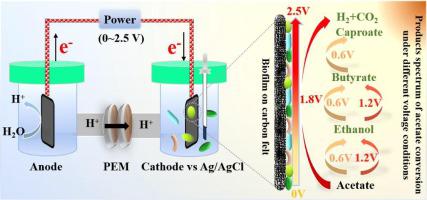Energy Conversion and Management ( IF 10.4 ) Pub Date : 2021-09-30 , DOI: 10.1016/j.enconman.2021.114804 Ping Wu 1 , He Liu 1, 2, 3 , Jing Li 1 , Peng Ding 1 , Chao Zhang 1 , Jie Zhang 1 , Qian Jiang 1 , Yan Zhang 1, 2, 3 , Min-hua Cu 1, 2, 3 , Jia-jie Xu 4

|
Acetate is the main component in the anaerobic digestion broth of organic waste, which is difficult to be extracted and further recovered because of its completely miscibility. A novel technology convert acetate to bioproducts (like ethanol, butyrate, and caproate) in electro-fermentation system by chain elongation microbiome has recently attracted attention. This work focused on the fate of acetate as substrate and sole electron acceptor under different applied voltage regulation. Products spectrum analysis showed that acetate was effectively converted and accumulated to a maximum concentration of 4.26 g L−1 ethanol firstly at 0.6 V, then butyrate (2.40 g L−1) and caproate (0.12 g L−1) were synthesized respectively. With the increase in voltage intensity, the bioconversion performance of acetate gradually deteriorated. The monitoring results of cathode chamber indicated an appropriate applied voltage creating a more favorable conversion environment for chain elongation microbiome, and a biocathode with better redox capability could act as an effective catalyst, contributing to the hydrogen-mediated electron transfer for chain elongation process. The correlation analysis between cathode multi-parameters and bioproduct performance at 0.6 V showed that the chain elongation process may be more dependent on the fermentation environment than the reduction of acetate to ethanol, especially for pH and redox potential. This study provides a sustainable and energy-saving platform for producing bioproducts from readily available acetate under the regulation of applied voltage.
中文翻译:

在外加电压调节下通过链延长微生物组催化将乙酸盐转化为生物制品
乙酸盐是有机废物厌氧消化液中的主要成分,由于其完全混溶,难以提取和进一步回收。一项通过链延长微生物组在电发酵系统中将乙酸盐转化为生物产品(如乙醇、丁酸盐和己酸盐)的新技术最近引起了人们的关注。这项工作的重点是乙酸盐作为底物和唯一电子受体在不同外加电压调节下的命运。产物光谱分析表明,乙酸盐首先在 0.6 V 下被有效转化并累积至最大浓度 4.26 g L -1乙醇,然后是丁酸盐(2.40 g L -1)和己酸盐(0.12 g L -1) 分别合成。随着电压强度的增加,醋酸盐的生物转化性能逐渐变差。阴极室的监测结果表明适当的施加电压为链延长微生物组创造了更有利的转化环境,并且具有更好氧化还原能力的生物阴极可以作为有效的催化剂,促进链延长过程中氢介导的电子转移。阴极多参数与 0.6 V 生物制品性能之间的相关性分析表明,与乙酸盐还原为乙醇相比,链延长过程可能更依赖于发酵环境,尤其是 pH 值和氧化还原电位。


























 京公网安备 11010802027423号
京公网安备 11010802027423号